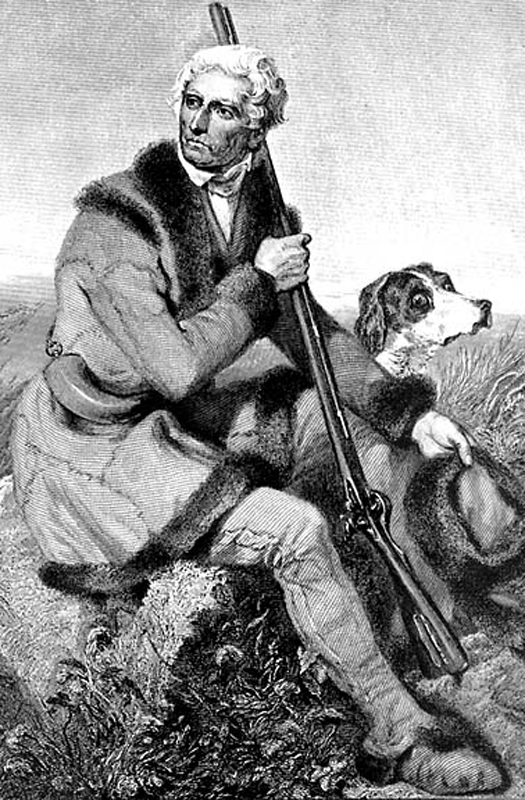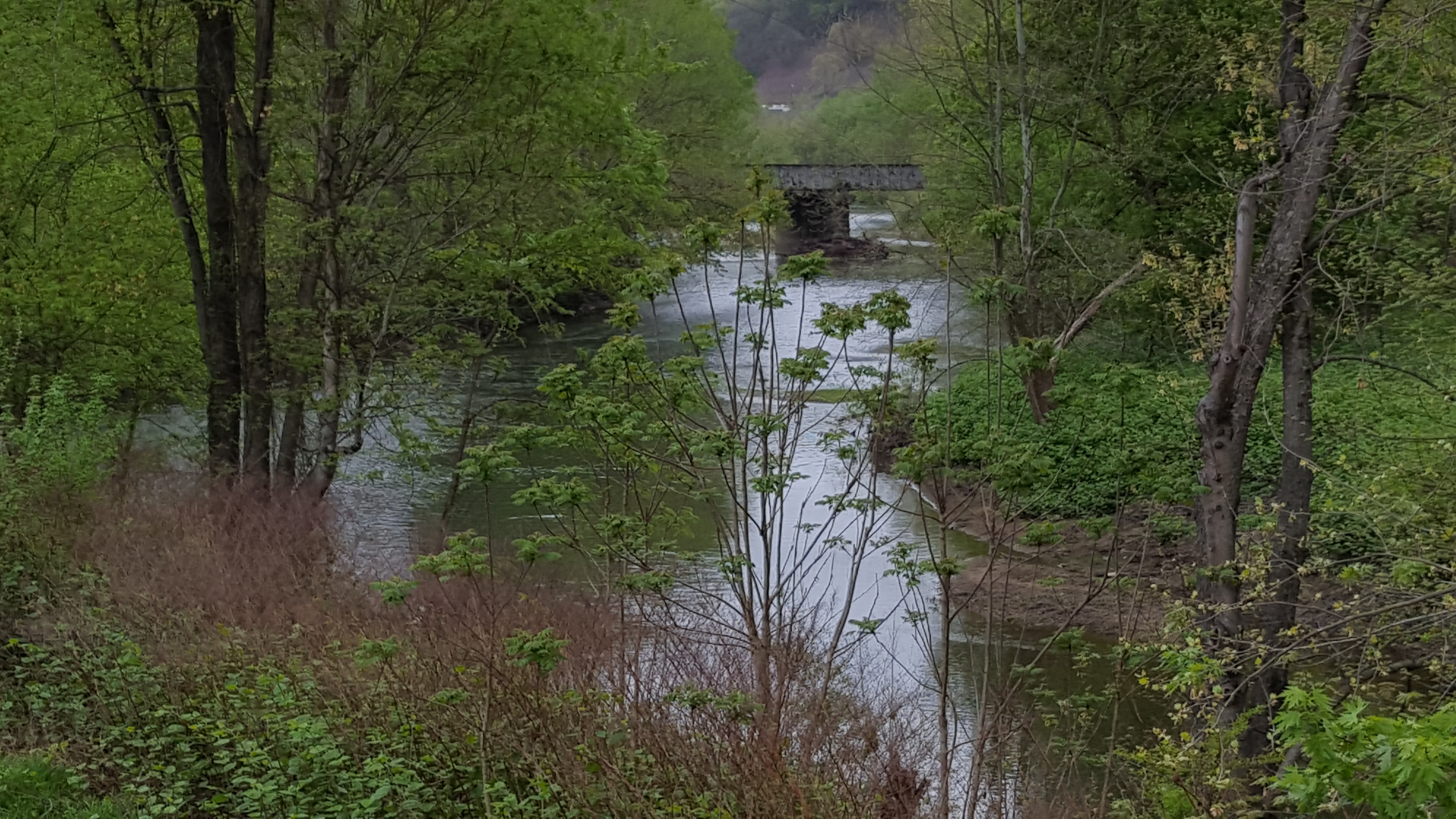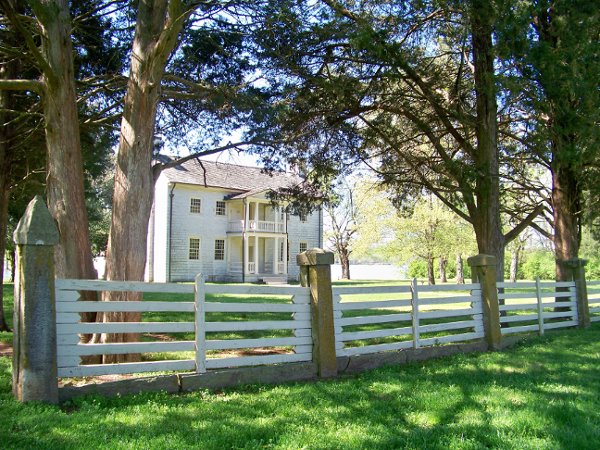|
Mansker's Fort
Mansker's Station, also called Mansker's Fort was a station along Avery's Trace in Middle Tennessee. It was built by Kasper Mansker. Kasper Mansker was a long hunter and explorer from the Virginia area. After his first expedition into the wilderness in 1769, Mansker explored and hunted widely in the area along the Cumberland River in Middle Tennessee and Kentucky. Mansker's station was a log fort that protected travelers along the road from Indian attacks. Mansker first built the fort along Mansker Creek in 1780, near Goodlettsville, after Fort Nashborough was built at the current site of Nashville. Because of the danger from the Indian wars, Mansker and the people living there abandoned the station and moved to Fort Nashborough in 1781. Two men who returned for possessions the next day were killed, and the original fort was burned down. However, Mansker returned to the area in 1783 and built a bigger fort about one mile from the original site where he lived with his wife El ... [...More Info...] [...Related Items...] OR: [Wikipedia] [Google] [Baidu] |
Avery's Trace
Avery's Trace was the principal road used by settlers travelling from the Knoxville area in East Tennessee to the Nashville area from 1788 to the mid-1830s. In an effort to encourage settlers to move west into the new territory of Tennessee, in 1787 North Carolina ordered a road to be cut to lead settlers into the Cumberland Settlements — from the south end of Clinch mountain (in East Tennessee) to French Lick ( Nashville). Peter Avery, a hunter familiar with the area, directed the blazing of this trail through the wilderness. He had the trail laid out along trails which the Cherokee Indians had long made their own and frequently used as war paths, following passages of buffalo. It led from Fort Southwest Point at Kingston through the Cumberland Mountains up into what is now Jackson County, Tennessee to Fort Blount. From there it worked through the hills and valleys of upper Middle Tennessee to Bledsoe's Fort at Castalian Springs, then to Mansker's Fort (near modern Goodl ... [...More Info...] [...Related Items...] OR: [Wikipedia] [Google] [Baidu] |
Kasper Mansker
Kasper Mansker or Casper Mansker also, spelled Mäintzger and Minsker (1750–1820) was a longhunter and one of Middle Tennessee's first European explorers and settlers. Early life Kasper Mansker was born on the European immigrant ship, ''Christian'', bound for the New World, in 1750. The Mansker family, possibly, came from Merchingen, Merzig-Wadern, Kreis District, Saarland, Germany, where the name is common. His parents, Ludwig Mäintzger and Maria Esch, were German immigrants, who settled in the British American colonies, but due to poor recordkeeping there are vague and conflicting reports about exactly where they lived. Mansker had four brothers, John, George, Sr., and Ludwig and one sister, Catherine. Kasper Mansker probably lived in the mid-Atlantic region of the American thirteen colonies. Various reports mentioned the whereabouts of Mansker in Pennsylvania, Virginia, and in what is now West Virginia. However, Mansker soon ventured west to explore the vast lands beyond ... [...More Info...] [...Related Items...] OR: [Wikipedia] [Google] [Baidu] |
Long Hunter
A longhunter (or long hunter) was an 18th-century explorer and hunter who made expeditions into the American frontier for as much as six months at a time. Historian Emory Hamilton says that "The Long Hunter was peculiar to Southwest Virginia only, and nowhere else on any frontier did such hunts ever originate."Emory L. Hamilton. ''Historical Sketches of Southwest Virginia 5: The Long Hunters'' (Wise, VA: Historical Society of Southwest Virginia, March 1970) The term, however, has been used loosely to describe any unofficial European-American explorer of the period. Most long hunts started in the Holston River Valley near Chilhowie, Virginia. The hunters came from there and the adjacent valley of the Clinch River, where they were land owners or residents. The parties of two or three men (and rarely more) usually started their hunts in October and ended toward the end of March or early in April, going west into the territory of present-day Kentucky and Tennessee. This was part of ... [...More Info...] [...Related Items...] OR: [Wikipedia] [Google] [Baidu] |
Cumberland River
The Cumberland River is a major waterway of the Southern United States. The U.S. Geological Survey. National Hydrography Dataset high-resolution flowline dataThe National Map, accessed June 8, 2011 river drains almost of southern Kentucky and north-central Tennessee. The river flows generally west from a source in the Appalachian Mountains to its confluence with the Ohio River near Paducah, Kentucky, and the mouth of the Tennessee River. Major tributaries include the Obey, Caney Fork, Stones, and Red rivers. Although the Cumberland River basin is predominantly rural, there are also some large cities on the river, including Nashville and Clarksville, both in Tennessee. Also, the river system has been extensively altered for flood control. Major dams impound areas of both the main stem and many of its important tributaries. Geography Its headwaters are three separate forks that begin in Kentucky and converge in Baxter, KY, located in Harlan County. Martin's Fork starts n ... [...More Info...] [...Related Items...] OR: [Wikipedia] [Google] [Baidu] |
Goodlettsville
Goodlettsville is a city in Davidson and Sumner counties, Tennessee. Goodlettsville was incorporated as a city in 1958 with a population of just over 3,000 residents; at the 2010 census, the city had a total population of 15,921 and in 2020 the population was 17,789. The northern half of the city is in Sumner County, while the southern half is in Davidson County. In 1963, when the city of Nashville merged with the government of Davidson County, Goodlettsville chose to remain autonomous. Geography According to the United States Census Bureau, the city has a total area of , of which are land and is water. History Goodlettsville was named for A. G. Goodlett, pastor of the Cumberland Presbyterian Church from 1848 to 1853. After emancipation of slaves following the American Civil War, the Ku Klux Klan was organized by Confederate veterans to maintain white supremacy over the freedmen. Following the Reconstruction era, violence of whites against blacks continued, often nomina ... [...More Info...] [...Related Items...] OR: [Wikipedia] [Google] [Baidu] |
Fort Nashborough
Fort Nashborough, also known as Fort Bluff, Bluff Station, French Lick Fort, Cumberland River Fort and other names, was the stockade established in early 1779 in the French Lick area of the Cumberland River valley, as a forerunner to the settlement that would become the city of Nashville, Tennessee. The fort was not a military garrison. The log stockade was square in shape and covered . It contained 20 log cabins and was protection for the settlers against wild animals and Indians. James Robertson and John Donelson are considered the founders, and colloquially, the "founders of Tennessee". The fort was abandoned in 1794, but the settlement, now the town of Nashville, became the capital of the new state of Tennessee in 1796. Background The American Revolution broke out one month after Richard Henderson's purchase agreement with the Cherokee for the lands of the proposed Transylvania settlement was signed in March, 1775. The purchase included land above the Cumberland River i ... [...More Info...] [...Related Items...] OR: [Wikipedia] [Google] [Baidu] |
Rock Castle (Hendersonville, Tennessee)
Rock Castle State Historic Site, located in Hendersonville, Tennessee, Hendersonville, Sumner County, Tennessee, Sumner County, Tennessee, is the former home of Daniel Smith (surveyor), Daniel Smith. Construction began in 1784; its completion was delayed by conflicts with area Native Americans in the United States, Native Americans and the house was completed in 1796. It is listed with the National Register of Historic Places and is open to the public. It is one of the Tennessee Historical Commission's State-Owned Historic Sites and is operated by the Friends of Rock Castle in partnership with the Tennessee Historical Commission. Daniel Smith Daniel Smith served as a captain in Lord Dunmore's War, a colonel in the American Revolution, and a Brigadier General of the militia in the Metro District. He was a member of the committee to frame the U.S. Bill of Rights, a Territorial Secretary of State, and a U.S. Senator. He also surveyed land boundaries in Middle Tennessee. Daniel Smi ... [...More Info...] [...Related Items...] OR: [Wikipedia] [Google] [Baidu] |
Bledsoe's Station
Bledsoe's Station, also known as Bledsoe's Fort, was an 18th-century, fortified, frontier settlement located in what is now Castalian Springs, Tennessee. The fort was built by long hunter and Sumner County pioneer Isaac Bledsoe (c. 1735–1793) in the early 1780s to protect Upper Cumberland settlers and migrants from hostile Native American attacks. While the fort is no longer standing, its location has been verified by archaeological excavations. The site is now part of Bledsoe's Fort Historical Park, a public park established in 1989 by Sumner County residents and Bledsoe's descendants. Bledsoe's Station was one of a series of frontier outposts built in the Upper Cumberland during the first major migration of Euro-American settlers into the Middle Tennessee area following the American Revolution. The fort was a convenient stopover along Avery's Trace—the main road connecting East and Middle Tennessee at the time. The flood of settlers into the region brought inevita ... [...More Info...] [...Related Items...] OR: [Wikipedia] [Google] [Baidu] |
Andrew Jackson
Andrew Jackson (March 15, 1767 – June 8, 1845) was an American lawyer, planter, general, and statesman who served as the seventh president of the United States from 1829 to 1837. Before being elected to the presidency, he gained fame as a general in the United States Army and served in both houses of the U.S. Congress. Although often praised as an advocate for ordinary Americans and for his work in preserving the union of states, Jackson has also been criticized for his racial policies, particularly his treatment of Native Americans. Jackson was born in the colonial Carolinas before the American Revolutionary War. He became a frontier lawyer and married Rachel Donelson Robards. He served briefly in the United States House of Representatives and the United States Senate, representing Tennessee. After resigning, he served as a justice on the Tennessee Supreme Court from 1798 until 1804. Jackson purchased a property later known as the Hermitage, becoming a wealthy plan ... [...More Info...] [...Related Items...] OR: [Wikipedia] [Google] [Baidu] |
John Overton (judge)
John Overton (April 9, 1766 – April 12, 1833) was an American planter, advisor of Andrew Jackson, a judge at the Superior Court of Tennessee, a banker and political leader. Early life and education Overton was born on April 9, 1766, in Louisa County, Virginia. His parents were James Overton and Mary Waller; his father was a great-grandson of Robert Overton, the Parliamentarian military commander during the English Civil War (and friend of Marvell and Milton). Career In 1787, he began his law career and moved to Nashville, Tennessee in 1789, to practice law at the Davidson County court. He was elected to succeed his friend Andrew Jackson as a member of the Superior Court of Tennessee in 1804, where he served as a judge until 1810. His elder brother Thomas Overton served as Jackson's second in his duel with Charles Dickinson. In 1819, he founded Memphis, Tennessee on land he owned with Andrew Jackson and James Winchester. He was elected a member of the American Antiquar ... [...More Info...] [...Related Items...] OR: [Wikipedia] [Google] [Baidu] |



